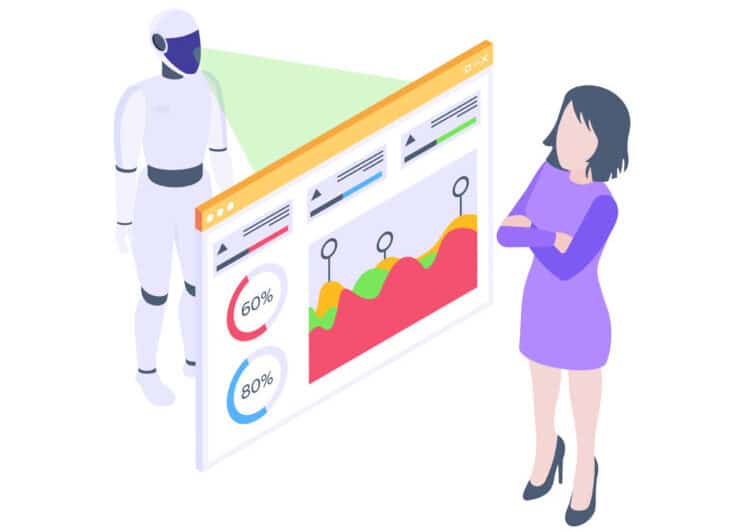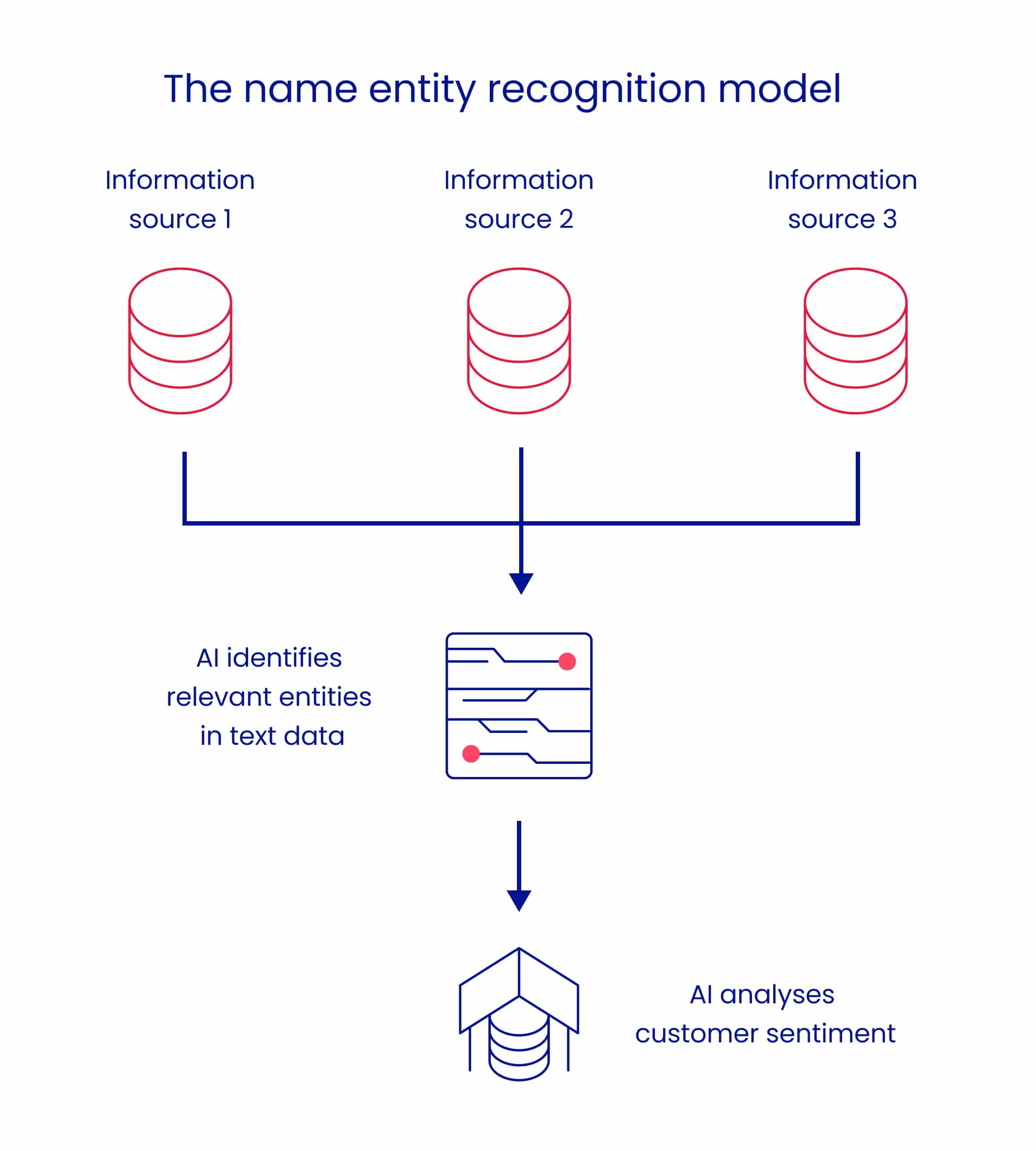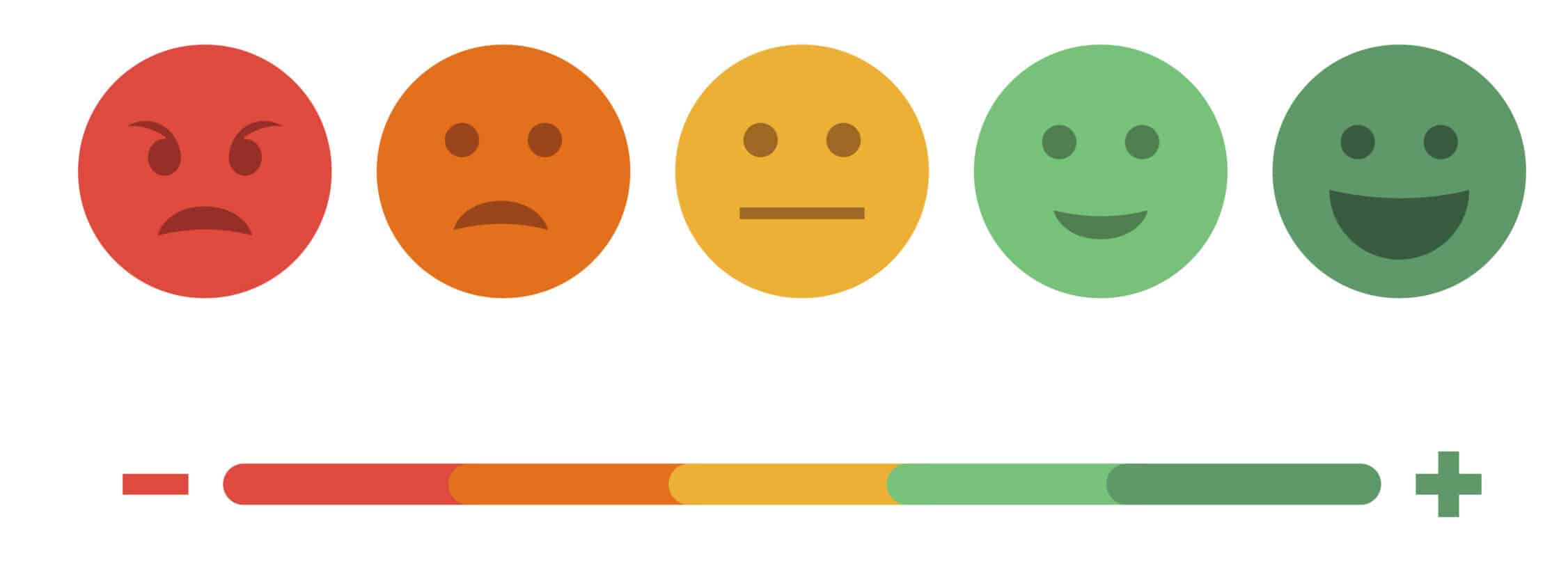In today’s digital world, understanding customer sentiment is a must for businesses if they want to provide the best experience possible. The numbers tell the story: studies have shown that customers are likely to spend 140% more after having a positive experience. In contrast, unhappy customers are likely to tell an average of 16 people about their negative experiences, thus creating a bad image of the company. This will be hard to balance out, as happy customers are likely to tell just nine people about their good experiences!
To keep a finger on the pulse of customer satisfaction level, businesses can implement AI-reinforced customer sentiment analysis. Such customer sentiment analysis uses data from customer feedback, e.g., online reviews and surveys, to understand what customers think about a business. By using this data and NLP services, businesses can identify both happy and unhappy customers to provide them with better service and products. Therefore, AI-powered analysis can ultimately enhance customer experience by revealing how customers feel about a particular product or service.
Let’s dive deeper into this version of AI-powered customer sentiment analysis.
What is AI-powered customer sentiment analysis?
Customer sentiment analysis utilizes natural language understanding and processing, text analysis, and machine learning algorithms to identify and extract subjective information from customer feedback and opinions in order to determine overall sentiment toward a product, brand, or service. The goal of sentiment analysis is to gain insight into how customers feel about a particular topic and to use this information to make informed business decisions.

- Marketing: Companies use sentiment analysis to track and analyze customer opinions and feedback about their products, services, and brand, in order to improve customer satisfaction and make data-driven marketing decisions.
- Customer Service: Sentiment analysis can be used by support teams to (partially or fully) automate customer service , prioritize and route support requests, as well as to understand customer sentiment towards their support interactions.
- Social Media Monitoring: Sentiment analysis can be used to monitor and analyze customer opinions on social media platforms, providing valuable insights into how customers feel about a brand, its products, and its competitors.
- Financial Services: Sentiment analysis can be used in the financial industry to track market sentiment and inform investment decisions, as well as to monitor customer sentiment towards a particular stock or financial product.
- Healthcare: Sentiment analysis can be used in the healthcare industry to monitor and analyze patient opinions about their experiences with healthcare providers, treatment options, and health insurance.
These are just a few examples of the many potential applications and use cases sentiment analysis offers across different industries.
Types of customer sentiment analysis
Sentiment analysis models emphasize mood, urgency, and intention. Depending on your desired outcome, you may personalize your sentiment analysis. The majority of automated methods use complex dictionary words usually interpreted as thoughts or emotions. For example, when customers leave Facebook comments describing their orders as “complicated,” sentiment analysis software will automatically take into account the aspects of the “orders” and the associated feelings. For example, in certain contexts, ‘complicated’ may be considered negative or frustrating.
Fine-grained analysis, emotion detection, and aspect-based sentiment analysis are all more advanced forms of customer sentiment analysis that provide a deeper and more nuanced understanding of customer sentiment.
A fine-grained analysis measures the polarity score of words in a text, allowing for a more precise assessment of customer sentiment, from very positive to very negative.
Emotion detection goes a step further: it identifies and analyzes specific emotions and moods within the text, providing a deeper understanding of how customers feel.
Aspect-based sentiment analysis breaks the text into smaller parts and measures the sentiment associated with specific aspects or features of a product or service, allowing for a more focused analysis of customer sentiment.
By combining these advanced analyses, companies can gain a more complete and detailed understanding of customer sentiment, making data-driven decisions based on that information.
Manual customer sentiment analysis
Customer sentiment analysis can be performed manually by reading and evaluating customer feedback and opinions, such as customer reviews, surveys, and support interactions.
Here are the steps to perform manual sentiment analysis:
- Collect customer feedback and opinions from various sources, such as customer reviews, surveys, and customer service interactions.
- Categorize this feedback into positive, negative, or neutral sentiments. This can be done by reading the text and evaluating the tone, language, and context of the feedback.
- Record the sentiment of each piece of feedback in a spreadsheet or database. This information can then be used to perform further analysis and extract insights.
- Analyze the recorded sentiment to understand patterns and trends in customer feedback. For example, you can calculate the proportion of positive, negative, and neutral feedback, or identify common themes in the feedback.
- Extract insights from the analyzed customer feedback, such as identifying areas for improvement or best practices for customer service interactions.
Analyzing feelings manually requires time and subjectivity. Such methods work best with small numbers, much less time, and a simple analysis—more could affect the result because people tend to interpret the feedback differently. At the same time, it can also provide a deeper understanding of customer feedback and be used as a baseline for comparison with automated sentiment analysis methods. In contrast, AI-powered customer sentiment analysis can sift vast amounts of data faster. In addition to providing more accurate customer-free feedback, this type of customer sentiment analysis tools is very inexpensive and significantly improves customer insights processes.
How AI enhances customer sentiment analysis
As mentioned above, manually analyzing customer sentiment is time-consuming and complex. AI (Artificial Intelligence) can enhance customer sentiment analysis by enabling an automated real-time processing of large volumes of customer feedback, providing businesses with valuable insights and actionable information at scale. Additionally, AI algorithms often outperform humans in speed, making fewer mistakes simultaneously.
NLP (Natural Language Processing) is a subfield of artificial intelligence (AI) that
enhances this procedure by allowing computers to understand, interpret, and extract meaning from human language. This enables sentiment analysis to be performed on large amounts of customer feedback data such as customer reviews, social media posts, and survey responses. NLP techniques such as sentiment analysis, text classification, and named entity recognition can be used to identify and categorize the sentiment expressed in each customer comment and provide insights into customer opinions and attitudes.
For example, the AI algorithm (called name entity recognition) can use the uploaded list of entities of interest, such as product or company names, to track their mentions across various channels, including social media platforms and review bases. By monitoring these channels regularly, the algorithm identifies any significant increase in the frequency of mentions of these entities, which can indicate loyalty level or a trend in customers’ sentiments.

Through natural language processing, companies can save time and resources, as well as make more accurate and data-driven decisions based on a complete understanding of customer sentiment. Additionally, NLP applications can help to scale such processes and improve the overall efficiency of customer feedback analysis
Where can we collect data for customer sentiment analysis?
Collecting data from multiple sources and using a combination of these methods can provide a more complete and accurate picture of customer sentiment.

There are several pathways to collect data for customer sentiment analysis:
-
Surveys:
Companies can use surveys to gather customer feedback and opinions. Surveys, administered online, by phone, or in person, can be designed to target specific customer segments or demographics.
-
Social Media:
Companies can monitor and analyze customer opinions on social media platforms, such as Twitter, Facebook, and Instagram, using social listening tools and sentiment analysis algorithms.
-
Customer Reviews:
Companies can analyze customer reviews on websites like Amazon, Yelp, and TripAdvisor to understand customer sentiment toward their products or services.
-
Customer Support Interactions:
Companies can use sentiment analysis to analyze customer interactions with customer service and support teams, such as email, chat, and call center interactions.
-
Website Feedback:
Website feedback tools, such as pop-up surveys, enable companies to gather customer opinions and feedback in real-time.
-
Text Data:
Companies can analyze unstructured text data sources, such as product descriptions, news articles, and blog posts, to understand customer sentiment toward a particular product or service.
The benefits of customer sentiment analysis
Customer sentiment analysis can provide a comprehensive view of the ways in which customers feel about a product or service. By gathering data on customer feedback and opinions, companies have the opportunity to improve unsatisfactory experiences as well as capitalize on those that are satisfactory. Such data can also help pinpoint opportunities for product or service improvements in order to better meet customer needs and expectations. Not only does this allow businesses to better serve their happy customers, but, by addressing any shortcomings, it also provides a chance to retain unhappy ones.

Here are some benefits of customer sentiment analysis:
-
Improved customer understanding
By analyzing customer sentiment, companies can gain a deeper understanding of their customers’ needs, preferences, and opinions, thereby informing business decisions and improving customer satisfaction.
When you perform sentiment analysis, you gain a quantitative measure of your customers’ emotions. This helps you identify:
- customer needs;
- unhappy customers;
- customer pain points.
-
Optimized customer experience
User experience is not only about how your product solves customers’ problems, but also about how they feel during the entire journey with you. The best way to understand it is by analyzing customer feedback. A customer sentiment analysis tool enables you to act on both positive and negative customer feedback, making it possible to fix any underlying issues and create a better experience for your users.
-
Increased customer loyalty
Better customer experience leads to more loyal customers. By using sentiment analysis to track and respond to customer feedback, companies can demonstrate that they value and care about their customers, which can increase customer retention.
-
Data-driven marketing
Sentiment analysis provides data-driven insights into customer opinions and attitudes, which can be used to inform marketing strategies, product development, and customer engagement.
-
Early warning system
Sentiment analysis can help identify negative sentiments early on, allowing companies to address customer concerns and resolve issues before they escalate.
-
Competitive advantage
By using sentiment analysis to monitor and analyze customer opinions, companies can gain a competitive advantage by staying ahead of industry trends and customer preferences.
-
Improved decision-making
Sentiment analysis provides valuable insights that can inform decision-making at all levels of an organization, from product development and marketing to customer service and support.
-
Improved customer service
One in every three customers is likely to leave a brand after one bad experience. Excellent customer service and timely guidance are essential for customer success. As a result, you can increase customer loyalty and create a more positive customer experience. It will also boost your product’s feature adoption rates, reduce friction, and boost product and user retention.
Instead of conclusion: best practices and tips of AI-powered customer sentiment analysis
Having delivered over 100 artificial intelligence projects, including successful AI upgrades of customer service departments, MindTitan experts have seen how NLP-enhanced data processing can provide significant efficiency, productivity, and profitability growth. Here are some of the best practices:
- Be sure to collect actual business data as it reflects customer/user sentiment. This will help you validate and monitor how each type of sentiment specifically affects your business.
- Start with simple models, validate the process, and then move on to more complex models.
- Be aware that many customers never leave feedback, which can be a serious blindspot. Thus, mine customers’ behavior patterns and map those patterns onto those customer patterns from extant feedback to estimate the sentiment of those customers who never leave explicit feedback.
- You are likely to have groups of customers that behave very differently. Taking this variety into account in sentiment analysis improves the results significantly.

